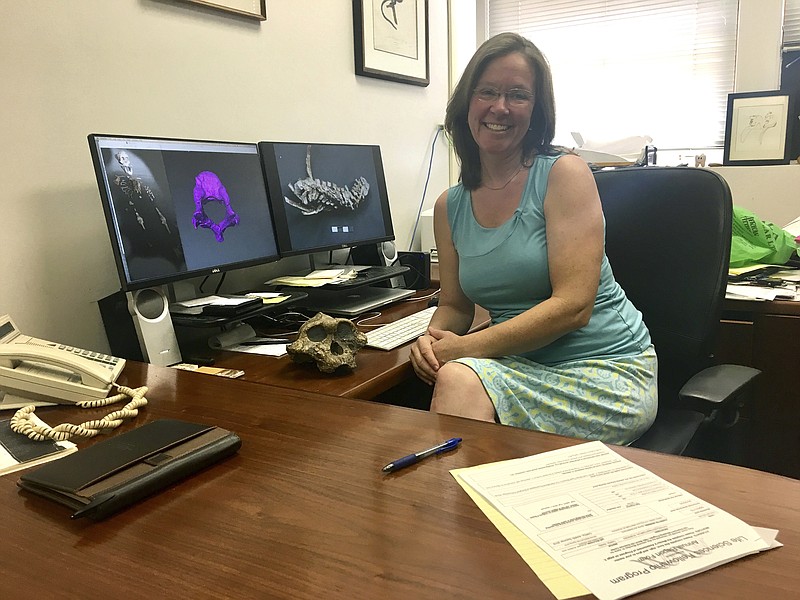COLUMBIA, Mo. (AP) - After more than a decade of painstakingly scraping away bits and pieces of sandstone grain by grain with dental tools and picks, a 3.3 million-year-old face, apelike in its features but unmistakably human, has been revealed. The face, is that of a female toddler, brings new life to the study of evolution and understanding of humans and how we stand.
Zeresenay Alemseged, a paleoanthropologist and professor of organismal biology and anatomy at the University of Chicago, discovered the "Dikika Baby," also known as "Selam," in the rocky desert of Dikika, Ethiopia in 2000.
Alemseged found roughly 70 percent of Selam's skeleton, which he said will help scientists further understand "how (this species') anatomy changed over time to see how we became the most dominant species."
"I was the only scientist on site," Alemseged said. "It was very exciting, but when you are in the middle of nowhere and one of the only people out with just a few others, there is a big responsibility."
Alemseged said he knew his discovery was important "right on the spot." However, the actual moment when he found the fossil was a blink of an eye in the scheme of things.
"It was one eureka moment of a long process," he said. "Making a discovery is just the beginning."
After Selam's skeleton was resurrected from the block of rock in which it was preserved, Alemseged expanded his research team to analyze what he had unearthed.
Carol Ward, a professor of pathology and anatomical sciences at MU and the lead author on the study, said she joined the team "when Zeresenay realized there were vertebrae and ribs because that's what I study."
Selam is not the first of her species australopithecus afarensis to be discovered, but she has the most complete spine of any others, including the famous "Lucy" skeleton discovered by Richard Leakey in 1974.
"This skeleton was probably washed away in a flood and would have been buried with all of the soft tissue still on it," Ward told the Columbia Missourian. "Then it became fossilized, so all of the little tiny bones in the back, ribs, voice box, shoulder blades and everything were fossilized together, which almost never happens."
A human body has 12 pairs of ribs while chimpanzees and gorillas, our closest relatives, have 13 pairs of ribs and fewer sets of lumbar vertebrae. The shorter rib cage and longer lower back in humans creates a waist that apes do not have. An ape's body is built to help it climb trees and swing among branches but does not allow for much twisting or swiveling of the waist to help it balance to walk on two feet for long periods of time.
"The number of vertebrae is a big deal in human evolution," Ward said. "And we haven't known if our earliest ancestors had only 12 pairs of ribs or had, like apes, 13."
Selam's spine shows her species had 12 sets of ribs.
"This confirms they would have had a very long, flexible lower back just like ours, which means they would have been able to move about the landscape just like we would," Ward said. "So if you got in your time machine and you flew back, you would see these apelike creatures, but ones that stood fully upright like us and walked like we do, not like they're half hunched over.
"The spine is really fundamental to how we hold ourselves upright and move, so to be able to know that that happened before 3.3 million years ago is a big deal," she said. "That's why we're excited about it."
Selam was only 2 years old when she died, which can be concluded from her mouth full of baby teeth. She had a small brain roughly the size of a chimpanzee's with a long jaw and a flat nose. Had she grown into an adult, she would have stood only a few feet tall.
The skeleton has never been to Missouri, so Ward has never held it in her hands. However, she has been able to study it from digital scans and 3D prints made in plaster. The digital copies have allowed the research team to fully remove the chunks of stone that still cling to Selam's bones and cannot be removed without damaging them.
Several studies will be based on the research from the discovery, including projects beginning to look at the growth of the skeleton to see how fast this species might have developed in relation to its age. Ward said there also will be analyses of the brain size and structure to observe how the skeletons matured.
"There will be a lot more projects coming from this skeleton within the next decade," Ward said.
Selam, which translates to "peace," will rest her bones in the National Museum in Ethiopia, but her body will continue to bring life to evolutionary studies. Ward said her value is "priceless. Just priceless."
"You go out in desert areas with big teams of people and you walk and you look, you walk and you look, and you walk and you look," Ward said. "It takes years and years. This is the find of a lifetime."

